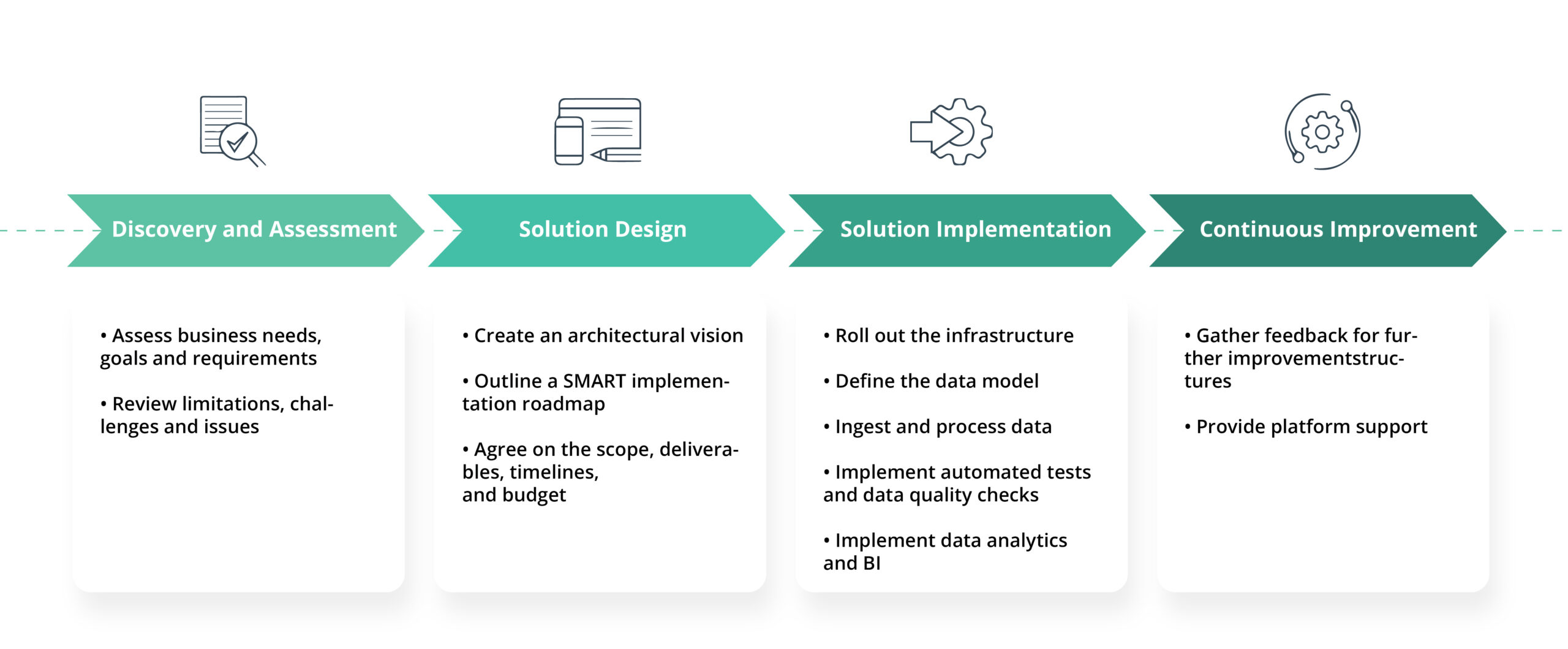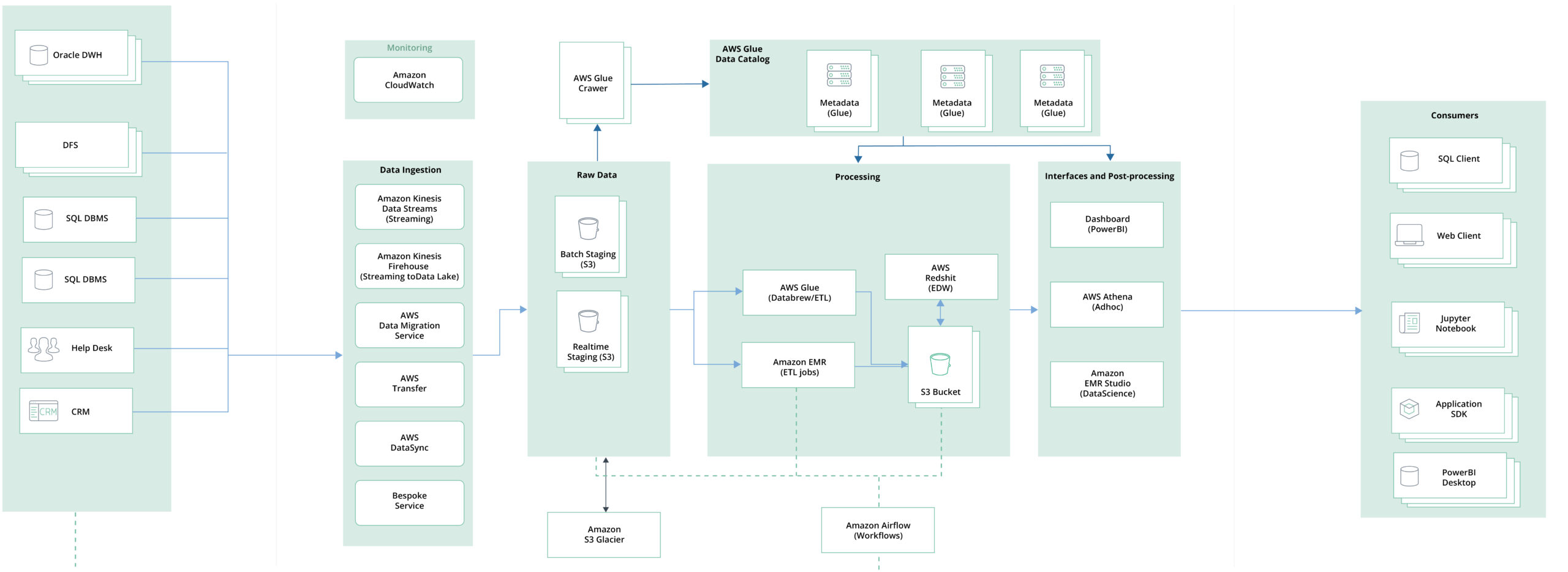Project highlights
- Enabling targeted growth: Through design and implementation of telecom big data analytics platform, Intellias empowered a cloud communications platform to set an ambitious growth target of two million users within two years.
- Operational optimization and reliability: Intellias optimized the client’s operations by aligning them with a robust product strategy and implementing a comprehensive data strategy, ensuring reliability and stability of the client’s infrastructure and achieving an impressive 99% uptime.
- Period of cooperation:
- 24 months
- Team size::
- 5 members (data engineering lead + 4 senior data engineers)
- Expertise:
- Cloud & DevOps, Platform Development, Telecom & Media, AWS
Business challenge
Today, there are two undeniable trends in telecommunications: the staggering proliferation of data and the supplanting of batch processing with real-time data processing. A US-based cloud communications platform powering telecommunications service providers took advantage of these trends and chose Intellias to enhance their expertise in big data analytics.
With all of their data being generated and processed in real time, our client, a US-based cloud communications platform powering service providers with a broad range of modern carrier-class telecom functions, needed to address a pivotal question: How does these trends impact their telecom analytics strategy? The resounding answer: They transform it entirely.
Here is how we helped our client reach this conclusion and devise a new analytics strategy.
Technology solution
Real-time analytics is catalyzed by factors such as the transition from 4G to 5G, the surge in IoT adoption, and the ever-expanding variety of connected devices. Consequently, communications service providers (CSPs) face a critical imperative: seize new revenue avenues and exert greater network control. This entails embracing innovative revenue models such as pre-paid services and integrated subscriber policy management.
Working with our client, we started from creating a data strategy for the next five years to help the cloud communications platform become data-driven. With a data strategy in mind, we then established the data analytics business process by conducting a design thinking workshop.

We helped at each step of our cleint’s data journey.
When working on our data projects, we follow a four-step process that includes a discovery and assessment stage, solution design, implementation, and continuous improvement. This is how we reach long-term benefits such as:
- Self-service analytics and data mining
- Seamless integration of heterogeneous data sources
- Scalability and minimal latency
- History preservation and time travel functionality
- Auditability and data profiling

When working on data projects, we go through four stages to reach long-term benefits.
The architecture of the real-time analytics platform integrates various technologies to ensure scalability, real-time data processing, and a seamless user experience. Here’s a breakdown of the high-level architecture
Data ingestion layer
- Uses Apache Kafka for high-throughput, real-time data streaming and messaging.
- Integrates with different data sources within the CSP (communications service provider) environment, such as call logs, message logs, network performance metrics, and user interactions.
- Implements connectors to ingest data into Kafka topics from diverse sources in real time.
Data processing layer
- Employs Apache Flink for stream processing and real-time analytics.
- Processes incoming data streams from Kafka topics and performs real-time transformations, aggregations, and enrichments.
- Integrates machine learning models for predictive analytics and anomaly detection to derive actionable insights from data.
Storage layer
- Uses a combination of database technologies based on specific use cases:
- NoSQL for high availability, scalability, and low-latency data storage
- PostgreSQL for structured data storage and relational queries
- Amazon RDS (Relational Database Service) to manage relational databases in the cloud
- Implements data partitioning and replication strategies to ensure fault tolerance and high performance.
Application layer
- Built using Java 11, Scala, and Spring Boot for developing scalable and resilient microservices.
- Implements business logic for real-time analytics, including data aggregation, visualization, and reporting.
- Exposes APIs to access analytics insights and integrate these insights with external systems.
Frontend layer
- Uses the Angular framework for building interactive and responsive web-based dashboards and user interfaces.
- Consumes APIs exposed by the application layer to fetch real-time analytics data.
- Provides intuitive visualization tools, charts, and graphs to present analytics insights to end users.
Testing and quality assurance
- Implements unit testing for individual components using JUnit.
- Conducts integration testing to validate the interaction between different layers and components.
- Uses Docker for containerization of testing environments, ensuring consistency and reproducibility.
Deployment and infrastructure
- Deploys the entire analytics platform on AWS cloud infrastructure.
- Uses AWS services such as Amazon EC2 for virtual servers, Amazon S3 for object storage, Amazon EMR for big data processing, and Amazon Redshift for data warehousing.
- Implements CI/CD pipelines using Docker for containerized application deployment, automated testing, and continuous AWS CodePipeline or Jenkins integration.

The architecture of the real-time analytics platform integrates various technologies to ensure scalability and real-time data processing.
Tech Stack

Business impact
Implementing a real-time analytics platform for our client (who operates a cloud communications platform) contributed to improved operations, a better customer experience, and increased overall competitiveness. Additional benefits:
- Optimized operations aligned with the company’s product and data strategies.
- Real-time analytics capabilities, allowing our client to target two million users in two years, prioritizing growth and innovation.
- 99% infrastructure uptime.
- Fortification of our client’s UCaaS market position.
The tangible business impact of integrating real-time analytics into the client’s operations showcases how data-driven insights contribute to accelerated growth in the competitive telecom market.
30%
Revenue increase as the result of real-time analytics platform integration
99%
Uptime for our client’s infrastructure
2M
Users targeted in two years, allowing our client to prioritize growth and innovation
